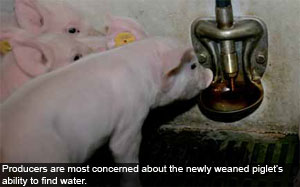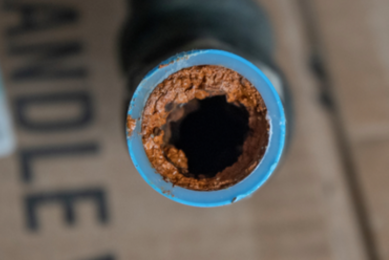Water balancing to maintain performance

Of all the nutrients in pig nutrition, water is the least reported yet it plays a huge role in performance. Monitoring intakes is a useful aid to management and can help identify subclinical problems. Recent research suggests that the management challenge may be balancing water intake with feed intake to ensure performance is maintained.
By Michelle Sprent, pig nutritionist, SCA NuTec, Dalton, North Yorkshire, UK
Water is often referred to as the forgotten nutrient, yet an adequate supply of fresh water is vital for successful pig production. It may be a very simple structure – just hydrogen and oxygen – but water is absolutely essential for all body functions and constitutes around 70% of the body. At birth piglets are 77% water and although this drops, 68% of the body make-up is still water at 100 kg liveweight.
Water is present in all cells as an essential transport mechanism, a diluent and a necessary component of all biochemical functions. Water must therefore be ingested by all pigs in sufficient amounts to sustain these processes. Despite these multi-pronged roles, water requirements in the pig are not as well defined as the requirements for other nutrients.
More recently, the importance of water has attracted a higher profile. It is now recognised as a much more valuable resource than it ever used to be and there’s new emphasis on the environmental impact of disposal of excessive amounts of slurry and other waste water from intensive pig units. Also, more attention is being placed on water consumption on research farms and many commercial units nowadays where water meters may be installed in each pen of pigs to monitor intake.
Monitoring water intake
At the Provimi research farm in the Netherlands water meters are installed in all accommodation from weaning to finish. Monitoring water intake can tell a story. From a commercial perspective a dramatic change in consumption by groups of pigs can indicate the onset of a subclinical infection or issues with temperature control for example. This monitoring can therefore help to explain some of the variations in growth rates seen throughout the growth period through to slaughter. For these reasons, water monitoring is an important management tool.
Growers/finishers
In growing and finishing pigs there is a very clear relationship between water consumption, feed intake and average daily body weight gain and this gets more critical in countries with high ambient temperatures. Intake will also be affected by water quality and on units where bore hole water is used a biannual check should be made. Table 1 provides a guide to the expected levels of various quality parameters which should be monitored.
Alarm bells should ring if pigs reduce their water intake by more than one third for three consecutive days. At this stage they should have a thorough health check and the water supply itself should be checked too.
Lactating sows
The importance of water in lactating sows is well recognised and to a certain extent her requirements are better understood than those of growing and finishing pigs. Top class units will utilise different techniques to ensure sufficient intakes are maintained for optimal milk production, for example offering extra water in the feed trough. As a guide lactating sows need a minimum flow rate of 2.5 litre/minute.
Newly weaned pigs
The area which is not so clear is the newly weaned pig. Newly weaned pigs are most commonly moving from a milk based diet to dry feed. Milk is 80% water and therefore clearly provides for a large proportion of the piglets requirements. If a piglet is consuming between 1 kg and 1.5 kg of milk per day then this equates to between 800 ml and 1,200 ml of water. In addition, suckling piglets will start to consume extra water from one to two days of age. At weaning this water therefore needs to be supplied in an alternative format.
Producers are most concerned about the newly weaned piglet’s ability to find water and the link between this and the critical aspect of feed intake. There is lack of data on intake in the early post-weaning phase and an additional lack of good data on requirements. Some research trials in the past have shown that piglets may experience difficulties finding water immediately post-weaning and that water consumption increased rapidly in day 2 and 3, believing that this signified that the piglet had found the water supply.
Quick find
Other published studies suggest this may not be the case and data generated recently on the aforementioned research farm found that piglets found their water source very easily. Water disappearance was measured on an hourly basis in individually housed piglets from the day of weaning at 21 days. Results are shown in Figure 2 and indicate that these piglets found water quickly.
Within three hours of weaning all piglets had visited the drinker and the majority had done so within the first hour. The measurement is purely water disappearance so may contain a certain element of wastage but the principle is that piglets can find the drinkers without difficulty. They also immediately fall into a diurnal pattern of drinking between the hours of 6 am and 7 pm. This behaviour was also observed in commercial group housed piglets where individual pen measurements showed water disappearance to be in the region of 20% and 25% of their body weight. This level of fluid consumption would be fatal in humans.
Water consumption
This ability to find drinkers and consume plenty of water is also observed in situations where growth and feed intake are measured and the calculated feed conversion ratio is less than 1:1. McLeese and others (1992) observed that piglet water intake followed two distinct patterns at weaning.
During the first five days intake was erratic and appeared not to be related to physiological need, growth, feed intake or digestive upsets. After five days, the piglets settled into a more consistent pattern that matched feed intake and growth just as we see in older pigs. In the company’s research data, both for individually and group housed pigs, this was also the case with piglets settling into a more consistent pattern from days three and four onwards.
So it appears that there is no need to worry too much over the piglet’s ability to find water. But perhaps there are more grounds for concern over the rapid intake of water in the early post-weaning days before the piglet settles into a pattern and which could mean that the piglet is ‘filling up’ on water and so reducing the desire to eat.
Restrict water access?
From a management viewpoint, it would not be wise to restrict the access to fresh water or limit the piglets’ ability to find the drinkers. But the focus should be on feed intake to ensure optimal performance.
Provision of ‘feed’ through the drinking system is an option however keeping such systems clean and hygienic is always a limitation as well as the fact that the piglet often experiences a second growth check when being weaned off such a system to conventional feed. Management techniques must be applied to encourage piglets to eat as soon as possible post weaning and this requires optimal feeds.
Piglets should be encouraged to maintain intakes of a post-weaning ration that is highly palatable and digestible to prevent intakes of feed dropping and performance suffering.
It seems that the theory that performance can drop post-weaning due to lack of water may not be the case and a greater threat is a fall in feed intake. Those producers recording intakes – of feed and water – will be in a strong position to pick up problems and fine-tune management and maintain high performance in this phase.











